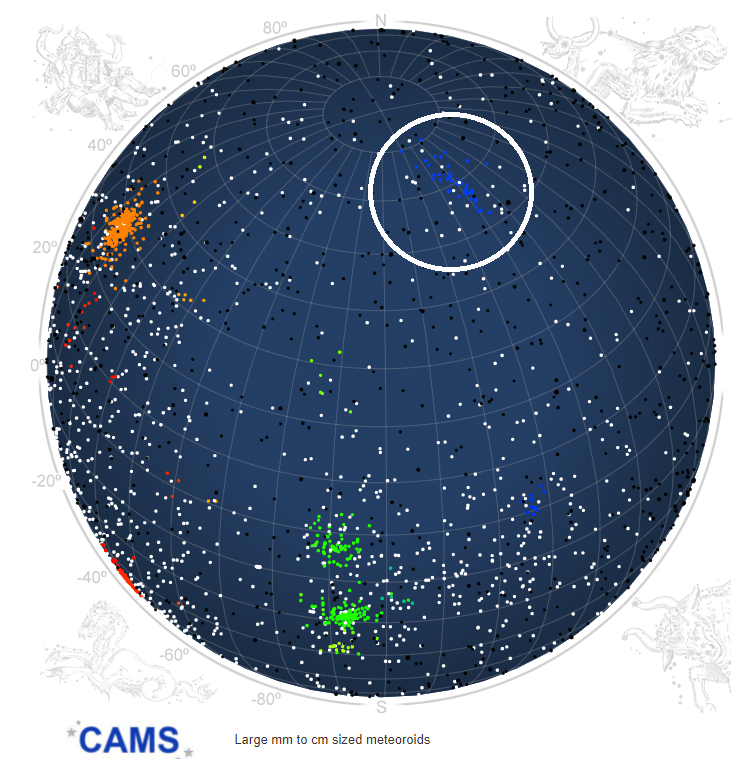Abstract: The kappa Cygnids are absent in most years, but the years 2020 and 2021 fit in a 7-year sequence of past returns when the shower was active. Modest activity was detected in 2020. Now, Northern-hemisphere networks of the CAMS video-based meteoroid orbit survey are detecting stronger activity of the kappa Cygnids than in 2020. In past returns, the shower peaked on August 13, a few days from now, close to the peak of the Perseids. The shower is known to produce occasional fireballs with multiple flares.
1 Introduction
The kappa Cygnids are an episodic shower, absent in most years, but clearly present in some. In those years when the shower is active, the radiant emerges from the antihelion source in late June, then moves gradually north towards Cygnus, where activity peaks in mid August.
Following an outburst in 2007, Masahiro Koseki first noticed that the active years came in a 7-year sequence (Koseki, 2014) and concluded that the shower might return again in 2021 (Koseki, 2020). Indeed, I find that since the first sighting in 1879, the kappa Cygnids have returned in 1893, 1950, 1957, 1978, 1985, 1993, 1999, 2007, and 2013/2014, quite regularly every 7.063 ± 0.019 years on average.
The peak of the shower coincides with that of the Perseids and, back in 1993, the kappa Cygnids photobombed the outbursting Perseids. The shower creates occasional fireballs that have multiple flares and are very photogenic. Observers in southern France noticed a -6 to -7 magnitude kappa Cygnid several nights in a row (Langbroek, 1993).
The years 2020 and 2021 fit in that sequence. The CAMS video network detected some kappa Cygnid activity in 2020. Now, CAMS BeNeLux (C. Johannink) reports that 2021 activity is stronger than that of 2020 (Figure 1).
2 Enhanced activity in 2021
All northern hemisphere networks of the video-based meteoroid orbit survey CAMS (Cameras for Allsky Meteor Surveillance) have detected the shower. There are CAMS networks in the USA (coordinated by P. Jenniskens, A. Howell, N. Moskovitz, J. Juneau, T. Beck, P. Gural, and W. Cooney), the BeNeLux (C. Johannink), and the United Arab Emirates (M. Odeh). Meteors filmed from two or more locations are tracked and triangulated to determine their path in the atmosphere. The radiant is the direction from which the meteors are seen to approach. The radiant plots for the combined network, displayed on the celestial sphere, can be consulted on the CAMS website selecting the date in the calendar.
The shower was first detected in late June, the radiant gradually moving to higher declination. On the night of Aug. 8 (solar longitude 135.6 deg), the shower radiant was elongated in a north-south direction and located just east of Vega at R.A. = 282.9°, Decl. = +44.1° (equinox J2000.0), with shower meteors having geocentric velocities of 21.6 km/s. These are relatively slow meteors.
In past returns, the shower has a shallow peak on August 13 (solar longitude 140.8), close to the peak of the Perseid meteor shower. The radiant then will be at R.A. = 285.6°, Decl. = +51.4° near kappa Cygni.

Figure 1 – Radiant plot displaying 41 κ-Cygnids (KCG#0012) recorded by CAMS networks between 2021 August 9.5 and 10.5 UT.
The shower makes a great target for photographic and spectroscopic observations and will delight the casual viewers of this year’s Perseid meteor shower in the days to come.
References
Jenniskens P. (2021). “Kappa Cygnid meteors 2021”. CBET 5014, 2021 August 9, editor Daniel W.E. Green.
Koseki M. (2014). “Various meteor scenes II: Cygnid-Draconid Complex (κ-Cygnids)”. WGN, Journal of the International Meteor Organization, 42, 181–197.
Koseki M. (2020). “Cygnid-Draconid Complex (kappa-Cygnids) II: Call for observations kappa-Cygnids 2021”. WGN, Journal of the International Meteor Organization, 48, 130–137.
Langbroek M. (1993). “Vuurwerk boen de Provence!! De aktiviteiten van het ‘dreamteam’ Rognes.” Radiant, Journal of the DMS, 15, 96–106.


Was out casually observing this morning between 5:30 UT to 8: 15 UT observed 10 KAPPA-CYGNID. No fireball, magnitude range between +3 to + 5, observed one around the + 7th magnitude in a 10 x 50 binoculars. At least something to observe since the morning of August 9 the Perseid at least for us, two morning after, have became a light shower and at times seem to have dried up visually from our location in Bell Ok,USA.